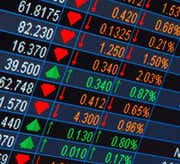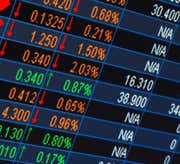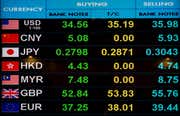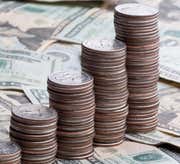While the majority of currency trading involves the U.S. dollar, major international currencies also trade among themselves. A currency trading pair that does not involve the U.S. dollar is known as a currency cross rate. For instance, a U.K. company with sales in Germany might wish to convert the euros it has received back into British pounds. The company does not need to convert euros into dollars before converting dollars into pounds. Instead, the U.K. company can use the EUR/GBP cross rate to convert the euros directly into pounds.
As discussed in the introduction to this tutorial, by far the two most heavily traded currencies in the world are the U.S. dollar and the euro. Because currency cross rates, by definition, do not include the U.S. dollar, the most heavily traded cross-rate pairs do involve the second most commonly used currency, the euro. In April 2016, the most popular cross-rate pair was the EUR/GBP, mentioned above, represented 2% of the total trades. Cross-rate pairs are also common among the other major international currencies, including the yen and the Swiss franc. Other, less liquid currencies often do not trade actively except against the U.S. dollar. For investors interested in transacting between these less liquid currencies, two trades must be made – first a conversion from the foreign currency into the U.S. dollar, followed by a second conversion from the U.S. dollar into the desired functional currency. (For background reading, see Make The Currency Cross Your Boss and The Foreign Exchange Interbank Market.)
Unique Characteristics of Cross Rates
There are several unique characteristics of currency cross rates. For one thing, an investor interested in cross rates does not need to be as concerned with the fundamentals of the U.S. economy as an investor trading more traditional pairs.
A second unique characteristic of cross rates is that they are usually somewhat less liquid (and less actively traded) than traditional pairs, bringing both benefits and drawbacks for investors. Because cross currency pairs are less heavily followed, investors may have greater opportunity to discover unique insights into market movements. It may also be more feasible for investors to find arbitrage opportunities if they are employing less commonly traded currencies. Finally, the relative lack of liquidity may result in greater volatility during turbulent periods. Greater volatility provides investors with the opportunity to generate larger profits (or the possibility of larger losses). The negative consequence of trading cross rates is that lower liquidity can result in wider bid-ask spreads; and, in extreme situations, traders may even have difficulty in entering or exiting their positions. (For more, see: The Fundamentals Of Forex Fundamentals)
Factors Influencing Cross Rates
Because most of the actively traded cross rates involve large international currencies such as the euro or the yen, the factors that influence these relationships are similar to those that influence a relationship between the U.S. dollar and other large international currencies. In particular, relative differentials in the countries' economic strength, inflation rates and interest rates typically cause the majority of market movements among these currencies.
Perhaps the most important factor in cross-rate movements is not what affects them, but what does not. Cross rates are not directly influenced by the direction of the U.S. dollar. When trading traditional pairs such as the EUR/USD, the USD/JPY, or the GBP/USD, it can be difficult for traders to differentiate their market views. That is because all of these relationships ultimately depend upon either the strength or the weakness of the U.S. dollar. There are exceptions to this; but, generally speaking, during a strong uptrend in the U.S. dollar, it is likely the dollar will advance against most of the other major currencies. When the dollar is suffering systemic weakness, it is likely that it will decline against most of the currencies. This means that regardless of which pair traders focus on, the most important determinant of their success will be whether they are bullish or bearish on the U.S. dollar.
When trading cross rates, though, a trader does not need a bearish or bullish view on the U.S. dollar. Instead, the movements in these relationships are determined by the fundamentals and market trends in their respective economies. These relationships provide investors with an excellent opportunity to diversify away from the U.S. dollar in their currency trading.
This does not mean, however, that traders of cross currency pairs can completely ignore the U.S. As the world's most important currency, the U.S. dollar's developments can send ripple effects throughout the currency markets. These effects can even influence pairs that do not directly involve the U.S. dollar. While movements in the U.S. dollar do have some impact on global exchange rates, they are not the primary determinant in a cross-rate relationship.
Trading Cross Rates
When trading one of the major pairs such as the EUR/USD, it is difficult for an investor to discover unique insight into market events. That is because the pair is so heavily traded in the marketplace that countless investors and traders are continually employing significant resources to forecast future market movements. However, by focusing on a slightly less popular cross rate, an investor can find more opportunities for contrarian opinions in the dynamics of the relationship. These opinions may lead to the possibility of higher returns than those found in the more traditional U.S. dollar-based pairs.
The opportunity to generate above-average returns by studying and researching cross currency pairs makes this corner of the currency market a potentially attractive one for investors. The key is to focus on one or two of the cross currency relationships and learn as much as possible about their movements. By doing so, investors may have the ability to profit in this less-closely-watched sector of the marketplace. (For more, see: How can I trade in cross currency pairs if my forex account is denominated in U.S. dollars?)
Forex Currencies: Emerging Market Currencies
-
 Trading
TradingPopular Forex Currencies
Learn about the most traded currencies and the strategies used to trade them. -
 Trading
TradingA Primer On Cross Currency Triangulation
The cross currency triangulation method is used to transact business in euros while making profits at home is essential. -
 Trading
TradingUnderstanding Forex Quotes
When trading in forex, all currencies are quoted in pairs. Find out how to read these pairs and what it means when you buy and sell them. -
 Trading
Trading6 top-traded currencies and why they're so popular
Every currency has specific features that affect its underlying value and price movements in the forex market. Learn why these currencies are especially popular for trading. -
 Trading
TradingThe Secret To Finding Profit In Pairs Trading
Read about a market-neutral trading strategy using relatively low-risk positions. -
 Trading
TradingThe U.S. dollar and the Japanese yen: An interesting partnership
Learn more about the USD/JPY relationship, wherein the yen can be partially explained in terms of Treasury bonds.



